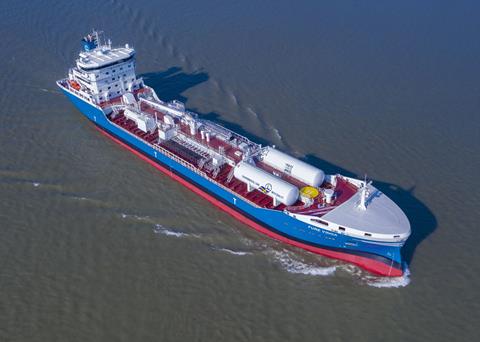The integration of hybrid propulsion systems is now seen as a strategic investment in the shortsea shipping segment, according to a November 2022 Wärtsilä webinar Future proof solutions for short sea shipping vessels.
The global shortsea fleet is estimated to consist of around 21,000 vessels, of which almost 40% is over 25 years old. A transition away from traditional diesel mechanical propulsion systems with a fixed pitch propeller is already underway, and as an aging fleet (average age 17 years globally and 18 years in Europe), it is anticipated that a wave of newbuildings will cement the transition further.
Newbuild ordering has been low for the last 15 years, but the need to decarbonise may lead to an uptake in ordering and upgrading activity that could drive up prices and create yard supply issues, says Jeremy Crossman, General Manager, Sales Excellence and coaching, Wartsila Marine Power.
Over the last few years, the traditional pre-2020 mechanical solution with fixed pitch propeller and the propulsion system separated from the electrical system has been giving way to a hybrid mechanical arrangement with a one or two main engines, a single controllable pitch propeller and a gearbox with /PTO which goes into a DC switchboard. The system also includes energy storage and shore power connection.
Typically, in new designs, the auxiliary plant is a bit smaller than in the traditional diesel-mechanical configuration, because the main engine and PTO is used more for auxiliary power. “We also see that future fuels are getting designed into many newbuild projects, whether that be LNG, methanol and ammonia and even some are talking about future hydrogen concepts onboard,” says Grant Gassner, Director, Integrated Solutions and Systems, Wartsila Marine Power.
The hybridised controllable pitch propeller has a lot of operating modes, and high flexibility, says Gassner, as a result of the ability to declutch the engine from the gearbox. “The shore connection is very valuable. You can go to zero emissions in port with a shore connection and battery very easily. You can also use your auxiliary engine in manoeuvring mode. If you need to move the vessel, you don’t necessarily need to start your main engine.”
Gassner says that the new, more flexible configuration running on LNG fuel can lead to over 50% less greenhouse gas emissions than traditional fixed pitch /mechanical propulsion systems, achieving good CII ratings well into the next decade with existing technology.
Hybrid propulsion systems can reduce OPEX and allow the flexibility to add energy saving technologies and new energy sources that enable shipowners to keep up with CII requirements. The complete decoupling of the engines from the propeller enables greater speed flexibility without being limited to one most efficient speed configuration, says Torsten Büssow, Director Ship Electrification Solutions, Wärtsilä Marine Power. It is also far simpler for replacing a genset with a fuel cell, a bigger battery, or a genset that can run on future fuels. If wind or solar power is added, the system is also suited to flexibly managing engine output power. Additionally, vessel designers have more flexibility in where they locate the engines.
Büssow cites some recent references, including a 5,000dwt bulk carrier newbuilding for Wärtsilä customer Misje Vita that has a hybrid mechanical system with main engine, gear box, /PTO and a DC hub connecting shore connection, tunnel thruster and the battery. Fuel consumption is expected to be 15% less than a comparable traditionally configured vessel.
Another newbuild vessel, a 16,500dwt bitumen tanker for Rubis Group which has a diesel electric configuration that optimises the vessel’s river and ocean passages and handles its relatively high hotel load.
A multi-purpose heavy lift vessel for SAL Heavylift, mainly to be used in the offshore wind industry, has recently been ordered with hybrid power. The vessel will have two methanol-ready main engines, /PTO and batteries, with a very small genset as a backup.
Johan Kristensson, Chief Operating Officer, Furetank, says his company’s Vinga series dual-fuel 18,000dwt product tankers are an example of the company’s leadership in energy efficient ship design. There will be 17 ships in the series which has scored the best Energy Efficiency Design Index (EEDI) value in its segment globally. The low EEDI is attributable to the unique combination of a ducted propeller, floating frequency on the main engine, and the hybrid technology where battery power can replace the auxiliary engines.
The Wärtsilä 9L34DF engine and associated fuel system means the vessels can operate on LNG, bio-LNG, e-LNG, gas oil, biodiesel and e-diesel, and Kristensson envisages the use of methanol or ammonia in the future. “We can have a wide scope of fuels on this vessel. That’s important for us, to be to be ready for various fuels in the future,” he says.






